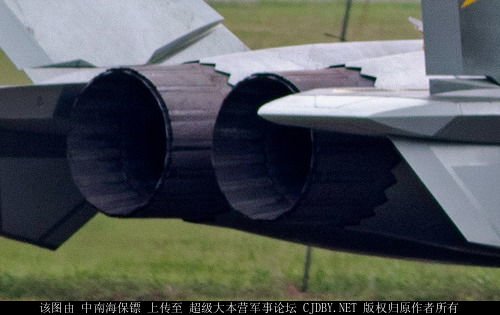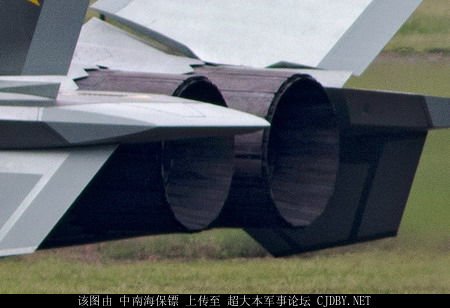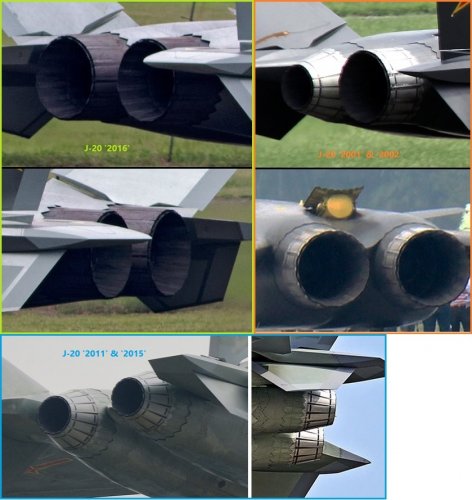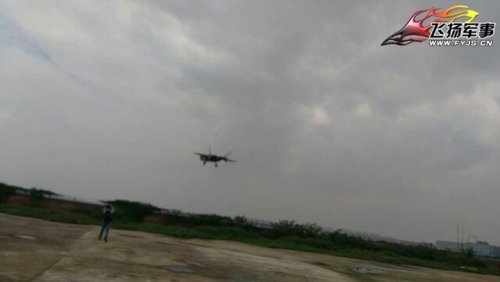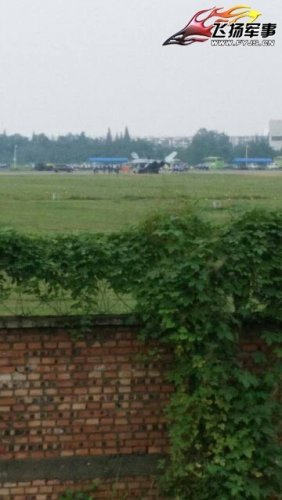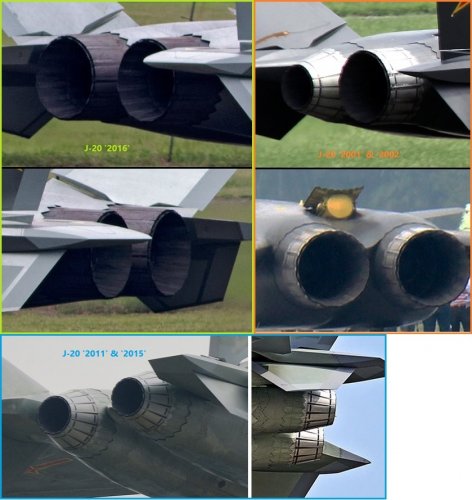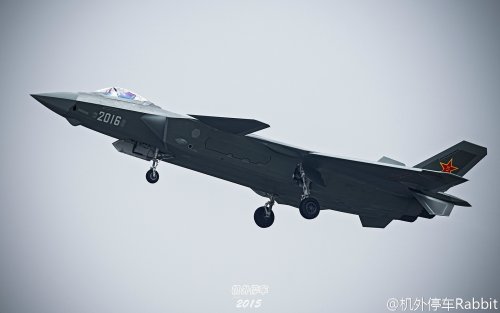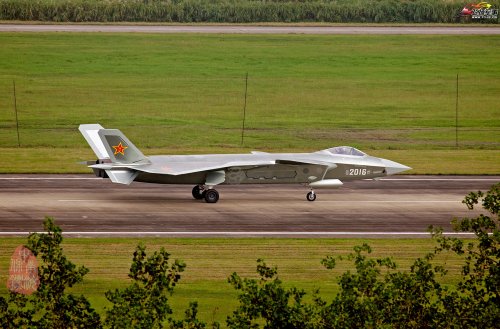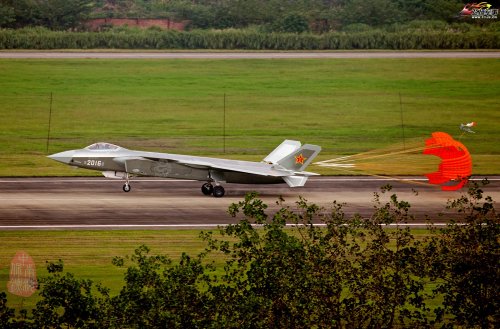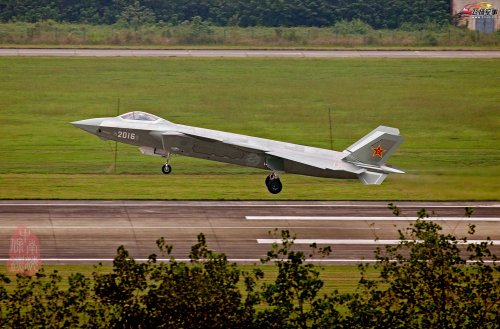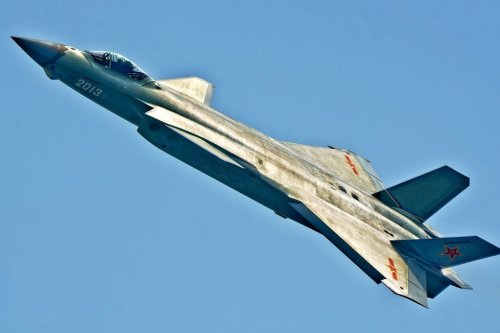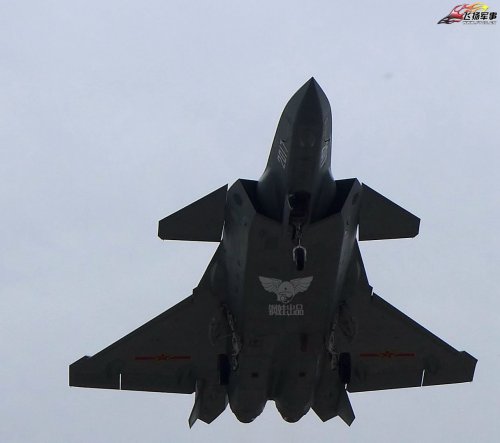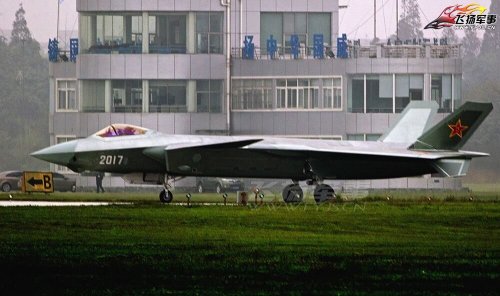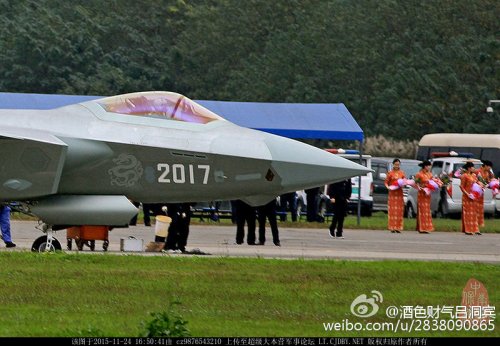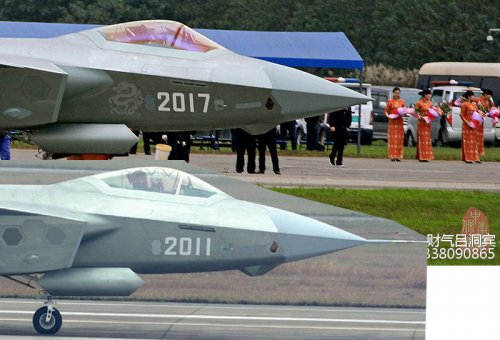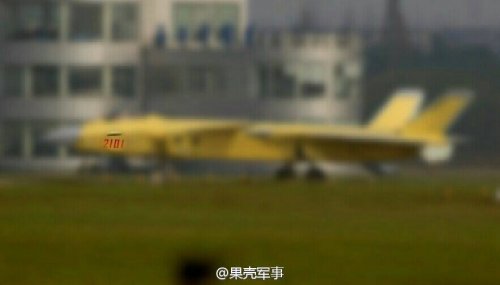You are using an out of date browser. It may not display this or other websites correctly.
You should upgrade or use an alternative browser.
You should upgrade or use an alternative browser.
Chengdu J-20 pictures, analysis and speculation Part II
- Thread starter overscan (PaulMM)
- Start date
- Joined
- 27 December 2005
- Messages
- 17,714
- Reaction score
- 26,194
Looks like it. I wouldn't expect reduced RCS nozzles until the definitive engine is fitted - its a lot of work to go through for a temporary solution. I doubt Russia will provide one.
- Joined
- 2 January 2006
- Messages
- 3,817
- Reaction score
- 5,019
PaulMM (Overscan) said:Looks like it. I wouldn't expect reduced RCS nozzles until the definitive engine is fitted - its a lot of work to go through for a temporary solution. I doubt Russia will provide one.
Indeed, however I wouldn't be surprised if there is again a similar contract between Saturn & CAC for a specialised, higher-thrust version of the AL-31FN similar to the original contract for the J-10.
Anyway two observations ...
1. I just tried to find a few similar shots of the other J-20 prototypes ... and quite interesting, '2016' is again more similar to the early birds '2001' & '2002" than to the last four. Biggest change IMO is however that the engine itself seems to be positioned deeper into the airframe ... or that serrated ring is longer !
2. Here's an interesting image I found somewhere showing one of the later '201x' prototypes after being re-engined ... seems as if '2016's configuration was already tested or am I wrong !??? and maybe again I'm wrong, but isn't one of the engines wider in diameter ??
Deino
Attachments
flanker
ACCESS: Top Secret
- Joined
- 20 March 2008
- Messages
- 933
- Reaction score
- 256
How so? What has J-20 shown that puts it closer to being serial production and operational that T-50 hasn't shown? Having more prototypes doesn't mean they are closer to an actual, operational, fighter. Especially with those engines.sferrin said:They certainly seem to be progressing through the iterative process faster than the Russians with their T-50.
2. Here's an interesting image I found somewhere showing one of the later '201x' prototypes after being re-engined ... seems as if '2016's configuration was already tested or am I wrong !??? and maybe again I'm wrong, but isn't one of the engines wider in diameter ??
Deino
You are waaaay overthinking this Deino. Modern engines have nozzles that regulate depending on thrust level and other parameters. The diameter isnt small because it is a different engine. It is small because the thrust level or other parameters are different between the engines. There are plenty of shots of for example of 2002 with "closed"/"narrow" nozzles and them "open". This kind of thing is seen on flankers and MiG-29's all the time.
- Joined
- 2 January 2006
- Messages
- 3,817
- Reaction score
- 5,019
flanker said:You are waaaay overthinking this Deino. Modern engines have nozzles that regulate depending on thrust level and other parameters. The diameter isnt small because it is a different engine. It is small because the thrust level or other parameters are different between the engines. There are plenty of shots of for example of 2002 with "closed"/"narrow" nozzles and them "open". This kind of thing is seen on flankers and MiG-29's all the time.
Yes, and I'm aware of this option for convergent/divergent nozzles, but at least in comparison to other images showing one open and the other one closed it looks - hmm to say at least - a bit different !
Deino
- Joined
- 3 June 2011
- Messages
- 18,308
- Reaction score
- 12,141
Deino said:flanker said:You are waaaay overthinking this Deino. Modern engines have nozzles that regulate depending on thrust level and other parameters. The diameter isnt small because it is a different engine. It is small because the thrust level or other parameters are different between the engines. There are plenty of shots of for example of 2002 with "closed"/"narrow" nozzles and them "open". This kind of thing is seen on flankers and MiG-29's all the time.
Yes, and I'm aware of this option for convergent/divergent nozzles, but at least in comparison to other images showing one open and the other one closed it looks - hmm to say at least - a bit different !
Deino

flanker
ACCESS: Top Secret
- Joined
- 20 March 2008
- Messages
- 933
- Reaction score
- 256
Deino said:flanker said:You are waaaay overthinking this Deino. Modern engines have nozzles that regulate depending on thrust level and other parameters. The diameter isnt small because it is a different engine. It is small because the thrust level or other parameters are different between the engines. There are plenty of shots of for example of 2002 with "closed"/"narrow" nozzles and them "open". This kind of thing is seen on flankers and MiG-29's all the time.
Yes, and I'm aware of this option for convergent/divergent nozzles, but at least in comparison to other images showing one open and the other one closed it looks - hmm to say at least - a bit different !
Deino
Now with that sferrin pic, should i post a dozen pics showing the same behavior on Su-27 and MiG-29 or are you good?
- Joined
- 27 December 2005
- Messages
- 17,714
- Reaction score
- 26,194
I'm actually not sure there isn't something more here, but I'll reserve judgement until I get home and look at it in detail.
- Joined
- 17 October 2006
- Messages
- 2,393
- Reaction score
- 1,196
Some people need to grow a clue. Why do you think the Russians and the Chinese don't seem to worry about rear-aspect RCS on the T-50 and J-20?
- Joined
- 2 January 2006
- Messages
- 3,817
- Reaction score
- 5,019
flanker said:Now with that sferrin pic, should i post a dozen pics showing the same behavior on Su-27 and MiG-29 or are you good?
O.k. !
- Joined
- 3 June 2011
- Messages
- 18,308
- Reaction score
- 12,141
LowObservable said:Some people need to grow a clue. Why do you think the Russians and the Chinese don't seem to worry about rear-aspect RCS on the T-50 and J-20?
Are we looking at the same planes? Aside from the nozzles (which in the later examples appear to show some attention to RCS reduction) the J-20 appears to show very close attention to RCS control at the rear.
- Joined
- 2 August 2006
- Messages
- 3,254
- Reaction score
- 1,524
sferrin said:[Are we looking at the same planes? Aside from the nozzles (which in the later examples appear to show some attention to RCS reduction) the J-20 appears to show very close attention to RCS control at the rear.
Really, I don't see that? In fact, there seems to be very little in terms of edge alignment between the trailing edge of the canard, the trailing edge of the wing and the trailing edge of the vertical tails. It seems to me the J-31 does a much better job in that regard.
latenlazy
I really should change my personal text
- Joined
- 4 July 2011
- Messages
- 245
- Reaction score
- 37
Sundog said:sferrin said:[Are we looking at the same planes? Aside from the nozzles (which in the later examples appear to show some attention to RCS reduction) the J-20 appears to show very close attention to RCS control at the rear.
Really, I don't see that? In fact, there seems to be very little in terms of edge alignment between the trailing edge of the canard, the trailing edge of the wing and the trailing edge of the vertical tails. It seems to me the J-31 does a much better job in that regard.
Supposedly, the trailing edge of the canard is the same angle as the trailing edge of the wing on the opposite side. Supposedly (I've never measured it myself, and am not even sure that's how it's supposed to work). That said, edge alignment isn't the only way to deal with RCS of edges.
- Joined
- 2 January 2006
- Messages
- 3,817
- Reaction score
- 5,019
Reportedly no. '2016' has made done its maiden flight at 15:35pm (Beijing Time) ... and landed safely 20 minutes later 
As such IMAGES PLEASE !!!!!! ... but anyway, congrats to CAC.
... but anyway, congrats to CAC.
As such IMAGES PLEASE !!!!!!
- Joined
- 2 January 2006
- Messages
- 3,817
- Reaction score
- 5,019
- Joined
- 3 June 2011
- Messages
- 18,308
- Reaction score
- 12,141
Sundog said:sferrin said:[Are we looking at the same planes? Aside from the nozzles (which in the later examples appear to show some attention to RCS reduction) the J-20 appears to show very close attention to RCS control at the rear.
Really, I don't see that? In fact, there seems to be very little in terms of edge alignment between the trailing edge of the canard, the trailing edge of the wing and the trailing edge of the vertical tails. It seems to me the J-31 does a much better job in that regard.
Attachments
- Joined
- 2 August 2006
- Messages
- 3,254
- Reaction score
- 1,524
latenlazy said:Sundog said:sferrin said:[Are we looking at the same planes? Aside from the nozzles (which in the later examples appear to show some attention to RCS reduction) the J-20 appears to show very close attention to RCS control at the rear.
Really, I don't see that? In fact, there seems to be very little in terms of edge alignment between the trailing edge of the canard, the trailing edge of the wing and the trailing edge of the vertical tails. It seems to me the J-31 does a much better job in that regard.
Supposedly, the trailing edge of the canard is the same angle as the trailing edge of the wing on the opposite side. Supposedly (I've never measured it myself, and am not even sure that's how it's supposed to work). That said, edge alignment isn't the only way to deal with RCS of edges.
True, it isn't the only thing, it's just the major thing. However, if what you're saying about the trailing edge is true, then that would make sense for a good LO platform from the rear. I don't see the nozzles, which aren't currently stealthy, being a big deal, since this is supposedly just the interim engine. I'm sure a production version would have a nozzle like the F-35 along with a turbine blocker. Also, if it is supercruiser, which I assume it is supposed to be, rear aspect stealth isn't nearly as important as it is from the front.
- Joined
- 17 October 2006
- Messages
- 2,393
- Reaction score
- 1,196
Just because it's a trailing edge doesn't mean it has no impact in the forward sector.
- Joined
- 2 August 2006
- Messages
- 3,254
- Reaction score
- 1,524
LowObservable said:Just because it's a trailing edge doesn't mean it has no impact in the forward sector.
Very true.
- Joined
- 3 June 2011
- Messages
- 18,308
- Reaction score
- 12,141
That's a beauty. When I was looking forward to seeing what the F-22 and F-23 were going to be like back in the day (before they revealed them obviously) I was hoping to see something like this. Certainly most of the released concepts at the time indicated a design leaning towards something like this. (Yes, I'm well aware that, "looks cool" generally isn't in the list of requirements.)
- Joined
- 27 December 2005
- Messages
- 17,714
- Reaction score
- 26,194
Sundog said:Very true.LowObservable said:Just because it's a trailing edge doesn't mean it has no impact in the forward sector.
That was what Rockwell didn't realise with their spanloader bomber. Trailing edge return is actually quite prominent in the forward sector.
- Joined
- 6 August 2007
- Messages
- 3,875
- Reaction score
- 5,870
PaulMM (Overscan) said:That was what Rockwell didn't realise with their spanloader bomber. Trailing edge return is actually quite prominent in the forward sector.
It was a little problem for the A-12 as well.
At different polarizations it can dramatically change the RCS in the forward sector.
FighterJock
ACCESS: Above Top Secret
- Joined
- 29 October 2007
- Messages
- 5,579
- Reaction score
- 5,896
Are there any design changes (internal or external) between 2016 and 2015? It looks as if the design is now frozen.
- Joined
- 2 January 2006
- Messages
- 3,817
- Reaction score
- 5,019
FighterJock said:Are there any design changes (internal or external) between 2016 and 2015? It looks as if the design is now frozen.
To admit, the most noticable changes are the engines: they now lack this strange silver colour/coating and the rear of that bird seems to be a bit modified. In regard to the DSI-bump I now think it is not changed at all but only painted/coated in a different colour or material. Otherwise the side weapons bays are much more visible (why ??) ....
Back to the engines and so a question to flamker & flateric;
I know I'm most likely playing around too much with that issue and even if You all corrected my last idea ... was there ever anything reported in Russia about a "secret" AL-31F or FN-deal with China in reagrd to the J-20 ??
I think - especially in other forums - many (esp. some fan boys) are even more obsessed by this topic and are sure that it is a WS-10A/B/G or even WS-15-prototype and I usually get a lot of critics to still insist that the J-20 is powered (in my opinion) by an AL-31FN series 3 or another "special" version arranged or ordered in a deal similar to the once secret first order to develop the AL-31FN for the J-10.
Or am I even more wrong ???
Thanks in advance,
Deino
Attachments
I
Ian33
Guest
Awesome! What an amazing bird. China really hit the sweet spot with this one. Love it, thanks for posting yet another awesome image.
- Joined
- 2 January 2006
- Messages
- 3,817
- Reaction score
- 5,019
RadicalDisconnect
Anthony Foulke
- Joined
- 28 April 2014
- Messages
- 212
- Reaction score
- 129
So it seems like the dorsal airbrake from 2001 and 2002 are now gone?
Also, people over at SDF have noticed that the canopy geometry changed slightly. Seems a bit taller than before.
Also, people over at SDF have noticed that the canopy geometry changed slightly. Seems a bit taller than before.
RadicalDisconnect
Anthony Foulke
- Joined
- 28 April 2014
- Messages
- 212
- Reaction score
- 129
It seems like they've tinted the canopy too. This program seems to be moving quite rapidly, though since China isn't very transparent who knows what problems may have arised.
- Joined
- 3 June 2011
- Messages
- 18,308
- Reaction score
- 12,141
RadicalDisconnect said:It seems like they've tinted the canopy too. This program seems to be moving quite rapidly, though since China isn't very transparent who knows what problems may have arised.
Probably had tougher security at the coatings company.
RadicalDisconnect said:It seems like they've tinted the canopy too. This program seems to be moving quite rapidly, though since China isn't very transparent who knows what problems may have arised.
I think previous J-20 prototypes have also been tinted before, and J-10B/Cs also seem to have a degree of tint... though that pic of 2017 definitely seems to have one with more visibility.
I expect they would've face a fair bunch of challenges and complications that come with standard prototype testing... but there doesn't seem to be any evidence of dramatic accidents at CAC at least (namely crashes or aircraft catching fire).
It will be interesting to see if they really do enter to LRIP after s/n 2017, and also when WS-15 may eventually find its way on J-20. That will probably be a big determinant for whether J-20 enters service in the 2017 to 2019 timeframe with an interim engine or an engine that will allow it to achieve actually competitive kinematics...
Similar threads
-
-
-
-
Shenyang FC-31 demonstrators / J-35 naval fighter / J-35A land-based version
- Started by Foxglove
- Replies: 994
-
Photos and analysis of China's J-20 fighter as it nears first flight
- Started by Foxglove
- Replies: 522

